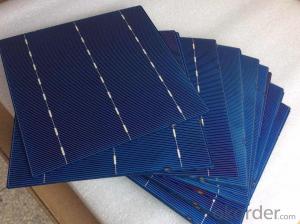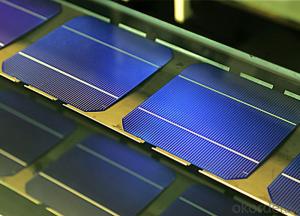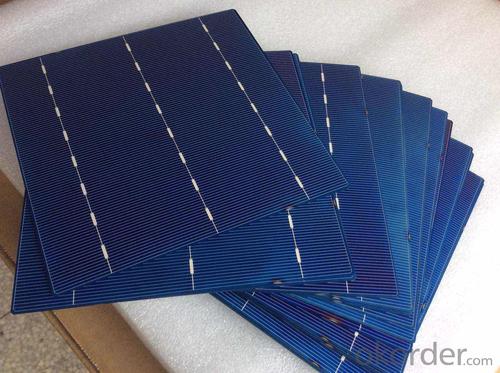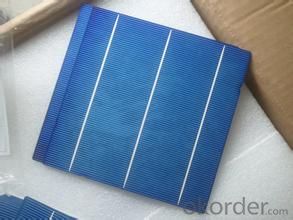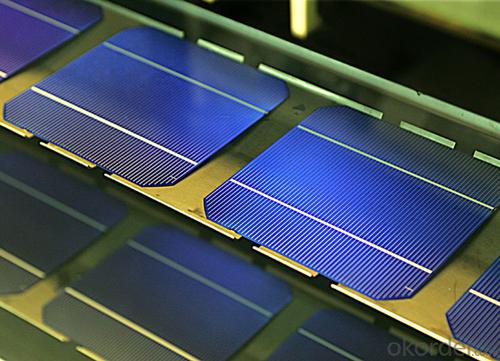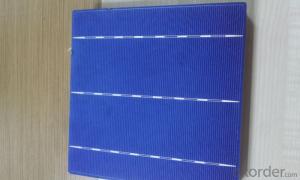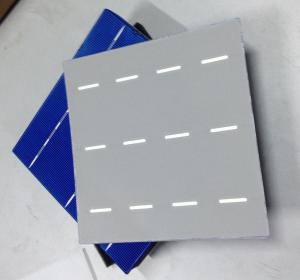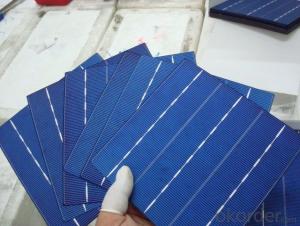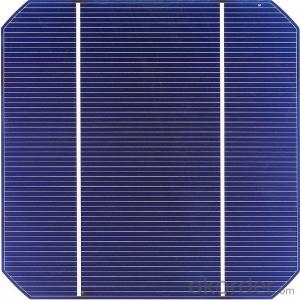4th Generation Polycrystalline Solar Cells - Tire 1 Manufacturer in China - 17.20%
- Loading Port:
- Shanghai
- Payment Terms:
- TT OR LC
- Min Order Qty:
- 10000 watt
- Supply Capability:
- 500000 watt/month
OKorder Service Pledge
OKorder Financial Service
You Might Also Like
Brief Introduction of Solar Cells
A solar cell, is an electrical device that converts the energy of light directly into electricity by the photovoltaic effect, which is a physical and chemical phenomenon. It is a form of photoelectric cell, defined as a device whose electrical characteristics, such as current, voltage, or resistance, vary when exposed to light. Solar cells are the building blocks of photovoltaic modules, otherwise known as solar panels.
Specifications of Polycrystalline Solar Cells
Format : 156 mm × 156 mm ± 0.5 mm
Thickness: 210 μm ±40 μm
Front (-) : 1.5mm bus bars (silver),blue anti-reflection coating (silicon nitride)
Back (+) : 2.5mm wide soldering pads (silver) back surface field (aluminium)
Efficiency (%) | Pmpp (W) | Umpp (V) | Impp (A) | Voc (V) | Isc (A) |
18.00% | 4.38 | 0.528 | 8.291 | 0.631 | 8.869 |
17.80% | 4.33 | 0.525 | 8.252 | 0.629 | 8.821 |
17.60% | 4.29 | 0.532 | 8.053 | 0.633 | 8.541 |
17.40% | 4.23 | 0.528 | 8.092 | 0.624 | 8.632 |
17.20% | 4.19 | 0.524 | 7.992 | 0.62 | 8.458 |
17.00% | 4.14 | 0.52 | 7.972 | 0.623 | 8.5 |
Advantage of Polycrystalline Solar Cells
1. Tire-1 Solar Cells’ Manufacturer Quality Guarantee. With a complete and sophisticated quality government system, our Quality Management have arrived world’s leading place. Customer can receive Tire-1 Cells Maker’s Quality Standard Products.
2. Trusted Warranty. We can supply trusted after-sales service to our customer. If our cells are found not in conformity to the specification of manufacturer, or should the inspected quantity found in shortage, or should the packing found damaged, the buyer has the right to claim to the seller. The claim, if any, should be presented to seller within 30 days after cargo's arrival date to the port, together with related inspection report and photos issued and provided by a reputable independent surveyor such as SGS.
3. World’s Leading Manufacturer Equipment. We imported the newest and leading production equipment from abroad. Advanced equipment can guarantee the stable quality of cells. Auto production line can also save labor cost which will further cut our production cost.
4. Bulk supply: With the production capacity of 500MW, we can produce large quantity every month. This can satisfy most customer requirement.
Usage of Polycrystalline Solar Cells
Solar cells are often electrically connected and encapsulated as a module. Photovoltaic modules often have a sheet of glass on the front (sun up) side, allowing light to pass while protecting the semiconductor wafers from abrasion and impact due to wind-driven debris, rain, hail, etc. Solar cells are also usually connected in series in modules, creating an additive voltage. Connecting cells in parallel will yield a higher current; our solar cells have passed IEC Certification. With high and stable quality, our cells can greatly improve the performance of Solar Modules.
Applications of Polycrystalline Solar Cells
Assemblies of photovoltaic cells are used to make solar modules which generate electrical power from sunlight, as distinguished from a "solar module" or "solar panel". A solar array generates solar power using solar energy.
Packaging & Delivery of Polycrystalline Solar Cells
Carton Box Package and Deliver by air. It should be noticed that it should be avoid of water, sunshine and moist.
Factory Picture of Solar Cells
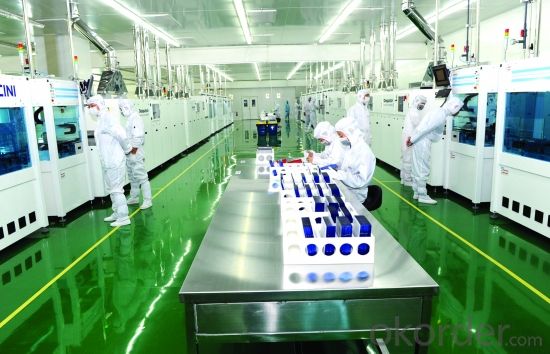
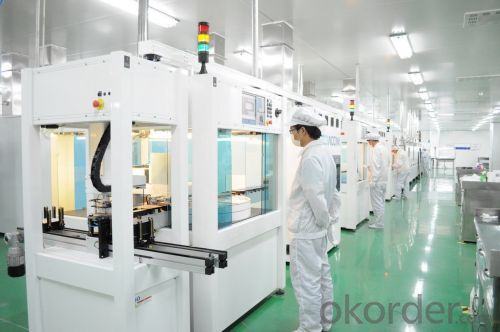
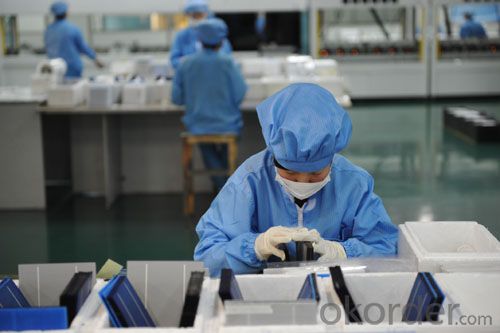
We have organized several common questions for our clients,may help you sincerely:
1. What’s price per watt?
A: It’s depends on the quantity, delivery date and payment terms of the order. We can talk further about the detail price issue. Our products is high quality with lower price level.
2. Can you tell me the parameter of your solar cells?
We have different series of cells with different power output, both from c-si to a-si. Please take our specification sheet for your reference.
3. How do you pack your products?
We have rich experience on how to pack the panels to make sure the safety on shipment when it arrives at the destination.
4. Can you do OEM for us?
Yes, we can.
5. How long can we receive the product after purchase?
In the purchase of product within three working days, We will arrange the factory delivery as soon as possible. The perfect time of receiving is related to the state and position of customers. Commonly 7 to 10 working days can be served.
- Q: Can solar cells be used in recreational vehicles?
- Yes, solar cells can be used in recreational vehicles. Installing solar panels on RVs allows them to harness the power of the sun to generate electricity, which can be used to charge batteries and power appliances while on the road. This helps to reduce reliance on traditional power sources, making RVs more energy-efficient and environmentally friendly.
- Q: Can solar cells be used in theme parks or amusement parks?
- Yes, solar cells can be used in theme parks or amusement parks. Solar panels can be installed on rooftops, parking structures, or open areas within the park to generate renewable energy. This energy can be used to power rides, lighting, and other facilities, reducing reliance on traditional electricity sources and lowering operating costs. Additionally, incorporating solar technology aligns with the sustainable and eco-friendly image that many theme parks strive to promote.
- Q: What is the role of solar cells in powering streetlights?
- The role of solar cells in powering streetlights is to capture sunlight and convert it into electricity, which is then stored in batteries. This stored energy is used to power the streetlights during the night, reducing the dependence on the electrical grid and minimizing energy costs and environmental impact.
- Q: Are solar cells affected by extreme temperatures?
- Yes, solar cells can be affected by extreme temperatures. High temperatures can cause the efficiency of solar cells to decrease, as excessive heat can cause an increase in resistance and reduce the voltage output. Similarly, extremely cold temperatures can also impact their performance, although to a lesser extent. It is important to note that modern solar cells are designed to withstand a wide range of temperatures, and their efficiency is typically optimized within a specific temperature range.
- Q: Are bulk solar cells better than the normal solar cells?
- Bulk solar cells are not absolutely better than normal solar cells, it is decided by what kind of material.
- Q: We are currently promoting our one of our solar cells seriers, which is the 156mmx156mm 6inch,2BB/3BB polycrystalline/multi solar cells,mono solar cell,made in Taiwan/Germany, please feel free to contact me if any interest.
- I am now in the process of purchasing some mono solar cells, can you send me more details of the product?
- Q: What is the impact of solar cell installations on job creation?
- Solar cell installations have a significant positive impact on job creation. By promoting the growth of the renewable energy sector, these installations create a wide range of job opportunities across various fields such as manufacturing, installation, maintenance, and research. The demand for skilled workers in solar-related industries has been steadily increasing, leading to job creation and economic growth. Additionally, the solar industry often provides employment opportunities at both the local and national levels, contributing to the overall development of the workforce and the economy.
- Q: Can solar cells be used in telecommunications systems?
- Yes, solar cells can be used in telecommunications systems. Solar cells can convert sunlight into electrical energy, which can then be used to power various components of telecommunications systems such as base stations, repeaters, and remote communication stations. This allows for more sustainable and independent operation of these systems, especially in remote areas where access to traditional power sources may be limited.
- Q: Is the solar cells factory in China good and trustworthy?
- As long as it's real factories which have passed related quality assurance tests with the authentic certificatse for producing the solar cells, they are good.
- Q: Can solar cells be used in shopping malls?
- Yes, solar cells can be used in shopping malls. In fact, many shopping malls around the world have already adopted solar panel systems to generate clean and renewable energy. These solar cells can be installed on rooftops, parking lots, or even as shading structures in outdoor areas, helping to reduce electricity costs and environmental impact.
Send your message to us
4th Generation Polycrystalline Solar Cells - Tire 1 Manufacturer in China - 17.20%
- Loading Port:
- Shanghai
- Payment Terms:
- TT OR LC
- Min Order Qty:
- 10000 watt
- Supply Capability:
- 500000 watt/month
OKorder Service Pledge
OKorder Financial Service
Similar products
Hot products
Hot Searches
Related keywords
